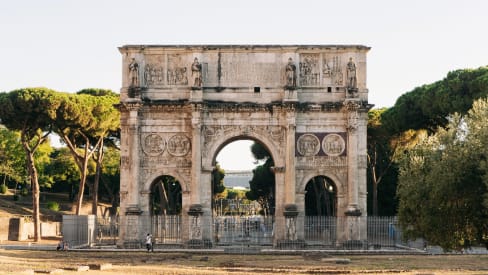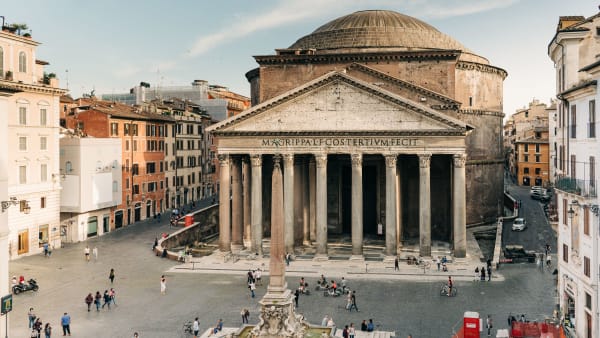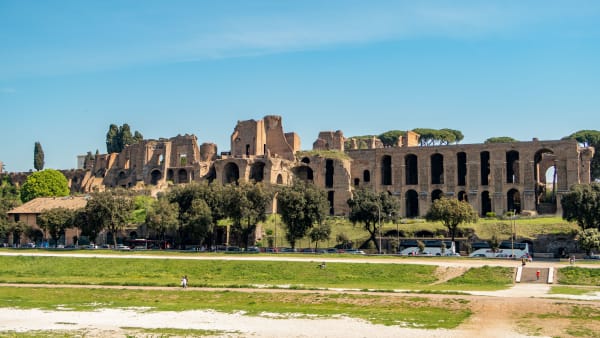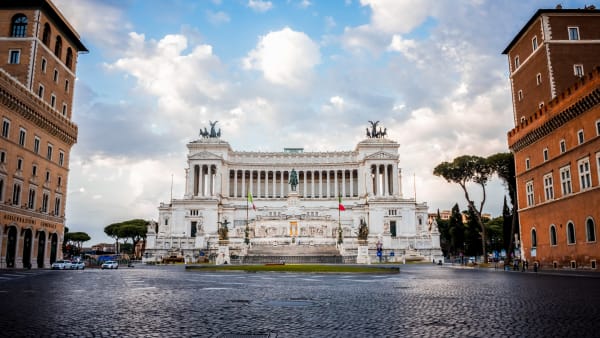Brief history
Brief history
Constantine the Great is known as the first Christian emperor of the Roman Empire. He said he owed his victory over Roman emperor Maxentius to the God of the Christians. This was an important battle in Roman history, which was immortalized with this beautiful monument.
Imperial period (27 BC - 476 AD)
The Arch of Constantine was erected on the ancient Via Triumphalis (the triumphal route to the Capitol), in celebration of the battle at Ponte Milvio in 312 AD, when the emperor defeated his rival Maxentius.
The construction ended three years later and the arch was inaugurated on July 25, 315—the tenth year of Constantine’s reign. The monument was never torn down, mainly because the emperor was the first to be in favor of the Christian religion, even though he converted at the end of his life.
The arch was built on behalf of the Senate, which dedicated it to the emperor. Partly to establish a good relationship with him and partly because he was indeed a courageous leader capable of defending the empire.
The facades of the monument are decorated with reliefs taken from honorary monuments erected for previous emperors, a practice known as spoglio. The purpose was to emphasize that Constantine’s Rome came to life based on the most glorious traditions. The arch lists the emperors who contributed most to the greatness of the Roman Empire and whom Constantine sought to emulate: Trajan, Hadrian, and Marcus Aurelius.
It seems that the monument was built in Hadrian’s time and then substantially rebuilt during the Constantinian period. For example, the columns were moved outside, the upper section was rebuilt, Trajan’s frieze was applied to the interior walls of the central arch, and reliefs and decorations from the Constantinian period were incorporated into the masonry. The Hadrianus Tondi is said to be original.
Much of the information known about the arch today comes from the controversial inscription above the middle passage, which is the same on both sides of the arch. It has confused various points of view, especially regarding the religious theme.
However, we can say that Constantine maintained a certain distance between religions, for reasons of political importance. This is reflected, for example, in the reliefs of the arch, both in the side aisles and on the facades, where scenes of sacrifices to pagan gods are found.
Middle Ages (476 - 1492)
On the upper part of the arch are four statues on the north side and four statues on the south side. These represent prisoners from Dacia who originally belonged to Trajan’s Forum. Because of these statues, the Arch of Constantine was called Arco dei Trasi in the Middle Ages.
During this period, streams of art fused, which is reflected in the reliefs of the arch. The older elements are based on a Greco-Roman concept of art. Unity of time, space, and movement were fundamental features.
In the elements of the Constantinian period, the above-mentioned features aren’t present. The spacing between the figures of the reliefs, for example, is minimal and everything seems to be crammed together. Also, the figures are less realistic as it’s more about the symbolic message of the composition.
For a long time, art historians took opposing positions on this and often criticized the Constantinian elements. They considered them the beginning of a “decadence of form.” In other words, a brutal incursion of anti-classical tendencies into “official” art, which would soon lead to the emergence of what is called “medieval art.”
Renaissance
As mentioned earlier, according to critics, the arch of this period seemed to emphasize a more popular and plebeian narrative, in contrast to the graceful attention to detail of the classical style and its complex spatial expressions. Scholars such as Berenson and Ghiberti, sculptors and those with considerable critical insight, saw in the Arch of Constantine “the end of classical art.”
Before the judgment of experts was so critical, the most prominent architects of the 15th century such as Brunelleschi and Alberti, wanted to measure and analyze the Arch of Constantine with various instruments.
Studies continued throughout most of the century until finally the arch was offered a starring role in the Sistine Chapel. Here, under the crown of a clear blue sky, the Arch of Constantine was elevated to a majestic setting for Botticelli’s frescoes.
In the 18th century, the arch was partially restored because in 1530 a vandal, Lorenzino de’ Medici, had cut off the heads of the reliefs for his amusement. As a consequence, he was exiled from Rome.
Contemporary period (1789 - present)
As mentioned earlier, the Arch of Constantine has been excellently preserved thanks to its strong connection with Christianity. From the moment the first ancient monuments were destroyed and reused, the people of Rome respected the monument as a symbol and reminder of the emperor who had granted historical dignity to the Christian religion. The work represented not only a military triumph (that of Constantine over Maxentius) but also a religious victory (that of Christianity over paganism).
While ancient Rome was destroyed over the centuries and monuments such as the Colosseum or the Roman Forum were degraded, the Arch of Constantine remained standing and intact.
In 1960, during the XVII Olympiad in Rome, the Arch of Constantine was the spectacular finish line of the legendary marathon won barefoot by Ethiopian Abebe Bikila.
This great monument of honor stands out for its grandeur and charm, especially at night when it is illuminated, conveying to the viewer the grandeur of ancient Roman power. The arch was thoroughly cleaned in the early 21st century, regaining its former splendor.















